Multimedia Gallery
Prince Rupert’s drops
Prince Rupert’s drops, glass structures resembling tadpoles, can withstand the blows of a hammer and yet burst into powdery dust at the slightest touch of their threadlike tails.
More about this image
An international team of researchers has pinpointed the source of the bizarre shatter-resistant behavior behind Prince Rupert’s drops, small glass structures that look like tadpoles and can withstand the blows of a hammer and yet burst into powdery dust by simply snipping their threadlike tails.
Germany’s Prince Rupert brought five of the enigmatic drops to England and presented them to King Charles II, who became interested in their extraordinary properties.
"Since the 17th century, famous scientists and natural philosophers have been trying to understand the exceptional properties of these drops," said Srinivasan Chandrasekar, a Purdue University professor of industrial engineering and director of the university’s Center for Materials Processing and Tribology. "Rupert’s drops have been a curiosity for about 400 years. On one hand, the head can withstand hammering, and on the other hand, the tail can be broken with just the slightest finger pressure, and within a few microseconds the entire thing shatters into fine powder with an accompanying sharp popping noise."
Measurements taken using a technique called integrated photoelasticity revealed the complex stress distribution in the drop as rainbow-colored bands when viewed through polarizing filters. Mathematical techniques, similar to those used in reconstructing 3-D information from medical CT scans, were then used to precisely recover the stresses based on the band patterns.
Previous research by Chandrasekar and a colleague from 20 years earlier in which they used high-speed photographic analysis of drop disintegration at nearly 1 million frames per second revealed individual cracks accelerating from the drop’s tail toward the head at more than 4,000 mph. This explained their explosive disintegration when the tail was snipped off.
While this earlier research examined the tail, the current research focused on the head’s amazing shatter-resistant behavior. Findings from the newer research showed the high strength of the head comes from compressive stresses calculated at around 50 tons per square inch, making them as strong as some grades of steel.
This research was supported by the U.S. National Science Foundation (grant CMMI 1562470).
To learn more about this research, see the Purdue news story Research solves centuries-old riddle of Prince Rupert’s drops. (Date image taken: 2017; date originally posted to NSF Multimedia Gallery: July 25, 2017)
Credit: Purdue University image/ Trevor Mahlmann
See other images like this on your iPhone or iPad download NSF Science Zone on the Apple App Store.
Images and other media in the National Science Foundation Multimedia Gallery are available for use in print and electronic material by NSF employees, members of the media, university staff, teachers and the general public. All media in the gallery are intended for personal, educational and nonprofit/non-commercial use only.
Images credited to the National Science Foundation, a federal agency, are in the public domain. The images were created by employees of the United States Government as part of their official duties or prepared by contractors as "works for hire" for NSF. You may freely use NSF-credited images and, at your discretion, credit NSF with a "Courtesy: National Science Foundation" notation.
Additional information about general usage can be found in Conditions.
Also Available:
Download the high-resolution JPG version of the image. (4.9 MB)
Use your mouse to right-click (Mac users may need to Ctrl-click) the link above and choose the option that will save the file or target to your computer.

 All images in this series
All images in this series